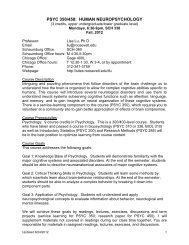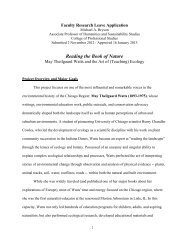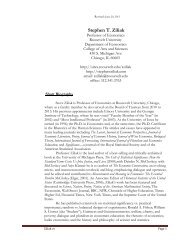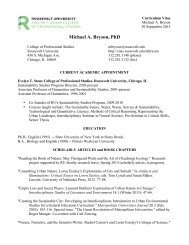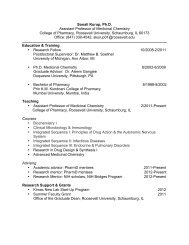Social Insurance and Public Assistance
public-assistance-welfare-reform-colonial-times-to-the-present-ziliak ...
public-assistance-welfare-reform-colonial-times-to-the-present-ziliak ...
You also want an ePaper? Increase the reach of your titles
YUMPU automatically turns print PDFs into web optimized ePapers that Google loves.
PUBLIC ASSISTANCE: COLONIAL TIMES TO THE 1920s 695<br />
TABLE Bf-A Important legislation <strong>and</strong> events affecting social welfare policy: 1601–1997<br />
1601 Elizabethan Poor Law: The “43rd of Elizabeth” laid the basis for the Poor Laws in Engl<strong>and</strong> <strong>and</strong> in the British colonies of<br />
America. The Act set in motion the idea that public responsibility for the poor should be guaranteed through a program<br />
of compulsory taxation.<br />
1610–1660 Sieckentroosters <strong>and</strong> Dutch Poor Relief in New Netherl<strong>and</strong>: The Dutch colony of New Netherl<strong>and</strong> (New York)<br />
established public responsibility for the poor, financed by donations to the Dutch Reformed Church. As early as 1626,<br />
two “sieckentroosters” were employed by the Church to visit <strong>and</strong> comfort the sick of present-day Manhattan, perhaps as<br />
America’s first social workers.<br />
1662 Act of Settlement: Applicants for public assistance had to prove residence in the parish or town to which they applied.<br />
The Act connected the idea of entitlement to relief to the prerequisite of local residence. Settlement laws were passed<br />
<strong>and</strong> enforced in the United States throughout the nineteenth <strong>and</strong> twentieth centuries.<br />
1775 First military pension program established by the Continental Congress. Set the precedent for military pensions for<br />
future wars.<br />
1787 Free African Society organized by Richard Allen <strong>and</strong> Absalom Jones, in Philadelphia. The Society was a self-help <strong>and</strong><br />
charitable organization for blacks. It was probably the first success among what would become a long line of<br />
independent black social organizations.<br />
1824 New York’s Act to Provide for the Establishment of County Poorhouses established that New York counties were to<br />
build poorhouses to provide shelter to applicants for public assistance. A number of states in New Engl<strong>and</strong>, the Middle<br />
Atlantic, <strong>and</strong> the Middle West passed similar legislation during the antebellum period.<br />
1862 Federal Civil War Disability Pensions were established for regular recruits <strong>and</strong> volunteers in the Union Army. Initially,<br />
the criteria for the eligibility <strong>and</strong> size of pensions were strictly tied to service-related injuries. The Arrears Act of 1879<br />
loosened that tie, <strong>and</strong> the 1890 Dependent Pension Act ended it. By 1910, 28 percent of all men aged 65 <strong>and</strong> over <strong>and</strong><br />
some 300,000 widows, orphans, <strong>and</strong> other dependents received benefits from veterans’ pension programs.<br />
1863 Massachusetts established the first Board of State Charities. Between 1863 <strong>and</strong> the 1900s, individual states established a<br />
central authority over the state’s institutions of public assistance. In many states, the central authority administered<br />
corrections, health, <strong>and</strong> lunacy, in addition to public assistance.<br />
1865 New York State legislature authorized the establishment of the Willard Asylum, the first state hospital for the chronically<br />
mentally ill, preparing the state for the removal of mentally ill paupers from poorhouses to state hospitals.<br />
1874 The first annual National Conference on Charities <strong>and</strong> Corrections (NCCC) brought together leaders of the nation’s<br />
public relief <strong>and</strong> private charitable organizations to discuss the similarity of their problems. The Charity Organization<br />
Society (COS), a quasi-private organization, dominated the agenda of the NCCC until 1905 when Jane Addams, a<br />
Progressive <strong>and</strong> a leader of the settlement house movement, was elected as its president.<br />
1874 First private pension program established by railroads.<br />
1875 The New York Children’s Act ordered the removal of all children between the ages of 2 <strong>and</strong> 16 from poorhouses to<br />
orphanages <strong>and</strong> other facilities. Other states passed similar acts over the last quarter of the nineteenth century. Reaction<br />
to the resulting family breakup <strong>and</strong> overcrowding of orphans’ homes provided a basis for the Progressive era movement<br />
toward Mothers’ Pensions.<br />
1877 The first COS was established in Buffalo, New York. During the last quarter of the nineteenth century, the COS led the<br />
movement that would abolish public outdoor relief in ten of the largest cities <strong>and</strong> bring sharp reductions to many other<br />
cities. The COS sought to replace public assistance with a voluntaristic <strong>and</strong> “scientific charity” based on distinctions<br />
between the “worthy” <strong>and</strong> the “unworthy” poor. By 1893, there was a COS in one hundred cities across the nation.<br />
1880 New York State Care Act: The Act required that all of the mentally ill in county institutions be moved to state hospitals<br />
<strong>and</strong> that the state assume complete responsibility for care of the insane poor. Other states created similar legislation<br />
during the late nineteenth century.<br />
1893–1894 An early experiment with public works: With the initiative of their COSs, the municipalities of Indianapolis <strong>and</strong> New<br />
York City used tax dollars to put to work many thous<strong>and</strong>s of adults who had been thrown out of work during the<br />
depression.<br />
1899 Charity Organization Society <strong>and</strong> the State of Indiana. The Indiana Legislature directed the Indiana Board of State<br />
Charities to implement the principles of the COS.<br />
1908 Federal Employers Liability Act declared unconstitutional. The Act increased the range of accidents for which railroad<br />
employers were required to make payments to injured workers by limiting their legal defenses in lawsuits.<br />
1908 Provision of workers’ compensation to federal employees involved in workplace accidents.<br />
1911 First permanent workers’ compensation acts passed by California, Illinois, Kansas, Massachusetts, New Hampshire,<br />
New Jersey, Ohio, Washington, <strong>and</strong> Wisconsin. Most other states <strong>and</strong> territories established the program over the next<br />
nine years. Mississippi was the last to establish a program in 1948. Workers’ compensation provided payments to the<br />
families of workplace accident victims <strong>and</strong> took the place of the earlier common law rules based on employer liability.<br />
1911 First state Mothers’ Pension law passed in Illinois. By 1920, forty states had established mothers’ pensions to provide<br />
regular payments to impoverished mothers of dependent children. These programs served as a model for the Aid to<br />
Dependent Children program established by the <strong>Social</strong> Security Act of 1935.<br />
1915 First state Old-Age Pension law passed by Alaskan territory. Provided pensions for elderly with low incomes to allow<br />
them to live outside the almshouse. By 1934, thirty states <strong>and</strong> territories had passed legislation.<br />
(continued)



